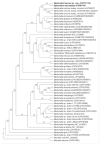First Report of Bartonella spp. in Marsupials from Brazil, with a Description of Bartonella harrusi sp. nov. and a New Proposal for the Taxonomic Reclassification of Species of the Genus Bartonella
- PMID: 36014025
- PMCID: PMC9414547
- DOI: 10.3390/microorganisms10081609
First Report of Bartonella spp. in Marsupials from Brazil, with a Description of Bartonella harrusi sp. nov. and a New Proposal for the Taxonomic Reclassification of Species of the Genus Bartonella
Abstract
The genus Bartonella (Rhizobiales: Bartonellaceae) encompasses facultative intracellular Gram-negative alphaproteobacteria that parasitize mainly erythrocytes and endothelial cells, as well as macrophages, monocytes and dendritic cells. Although they can infect numerous mammal species and arthropod vectors worldwide, reports of Bartonella infections in marsupials are scarce. In fact, such agents have only been detected in marsupials and/or associated ectoparasites in Australia and the United States of America until the present moment. The present study aimed to isolate and characterize molecularly, morphologically and phenotypically Bartonella infecting free-living marsupials sampled in the Brazilian Pantanal, the largest wetland in South America. Two marsupials were captured in December 2018 and six marsupials in February 2019, totaling eight small mammals sampled: five (62.5%) Thylamys macrurus and three (37.5%) Monodelphis domestica. All blood samples were submitted to qPCR for Bartonella spp. based on the nuoG gene, a pre-enrichment liquid culture and a chocolate agar solid culture. Bartonella sp. was isolated from 3 T. macrurus and one M. domestica. One Bartonella isolate obtained from a T. macrurus blood sample (strain 117A) that showed to be closely related to the Bartonella vinsonii complex and Bartonella machadoae was selected for whole genome sequencing using a hybrid approach based on Illumina NovaSeq and Nanopore sequencing platforms. This strain showed a genome of 2.35 Mbp, with an average C + G content of 38.8%, coding for 2013 genes, and a 29 kb plasmid with an average C + G content of 34.5%. In addition, this strain exhibited an average nucleotide identity (ANI) of 85% with Bartonella species belonging to the B. vinsonii group and 91% with B. machadoae. Phylogenomic analysis based on 291 protein coding genes shared by the genomes of 53 Bartonella species positioned this strain closely to B. machadoae. This new isolated species was named Bartonella harrusi sp. nov., which was characterized as having small capnophilic, microaerophilic and aerobic rods with an absence of pili and flagella. In conclusion, the present work describes the biochemical, phenotypic and genomic characteristics of Bartonella harrusi, a new species isolated from the T. macrurus blood samples of the Brazilian Pantanal. Finally, a review of the taxonomic classification of members of the genus Bartonella is proposed, based on the ANI values accessed by whole genome sequencing analyses.
Keywords: WGS; bartonelosis; biochemical characterization; marsupialia; phylogenomics; taxonomic classification.
Conflict of interest statement
The authors declare no conflict of interest.
Figures









References
-
- Gutiérrez R., Shalit T., Markus B., Yuan C., Nachum-Biala Y., Elad D., Harrus S. Bartonella kosoyi sp. nov. and Bartonella krasnovii sp. nov., two novel species closely related to the zoonotic Bartonella elizabethae, isolated from black rats and wild desert rodent-fleas. Int. J. Syst. Evol. Microbiol. 2020;70:1656–1665. doi: 10.1099/ijsem.0.003952. - DOI - PubMed
Grants and funding
- 2018/02753-0/São Paulo Research Foundation
- 2018/19672-2/São Paulo Research Foundation
- 303701/2021-8/National Council for Scientific and Technological Development
- 401403/2016-5/National Council for Scientific and Technological Development
- 308768/2017-5/National Council for Scientific and Technological Development
LinkOut - more resources
Full Text Sources
Miscellaneous

